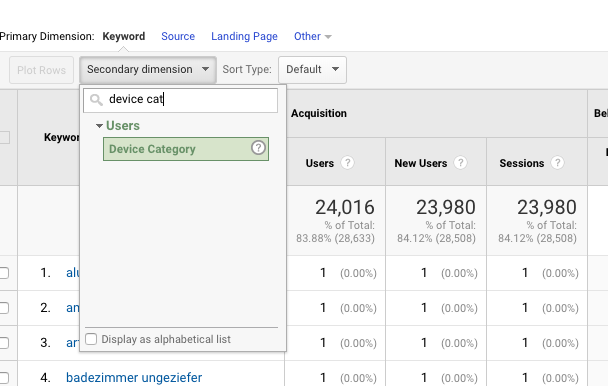Secondary Dimension in Google Analytics: Unlocking Advanced Metrics
Secondary Dimension in Google Analytics: Unlocking Advanced Metrics
Blog Article
Transform Your Analytics Approach With Secondary Dimension in Google Analytics
Exploring the possibility of additional measurements in Google Analytics opens a realm of possibilities for businesses looking for to boost their logical strategy. By integrating additional dimensions right into information evaluation, a brand-new layer of understandings emerges, clarifying complex individual habits and communications. This sophisticated level of scrutiny not only improves advertising and marketing strategies yet also deciphers concealed opportunities for optimization and growth. The calculated application of secondary dimensions holds the vital to opening a bonanza of important info that can revolutionize exactly how businesses translate and act upon their information.
Comprehending Second Dimensions in Google Analytics
Additional dimensions in Google Analytics offer extra context to key information by permitting customers to assess metrics across a second measurement, using deeper understandings into customer habits and communications on an internet site. Secondary Dimension in Google Analytics. While main dimensions provide essential data factors such as pageviews, bounce rate, and session period, secondary dimensions use a more thorough sight by segmenting the main information even more. This segmentation enables customers to examine metrics in mix with an additional measurement, such as website traffic sources, demographics, or user habits
Advantages of Utilizing Second Dimensions
Making use of additional measurements in Google Analytics offers a strategic benefit by enhancing the depth of evaluation and giving a more extensive understanding of user communications and habits on a website. By including second dimensions, analysts can obtain useful insights into the efficiency of specific sections or variables within their information. This enables a more in-depth assessment of customer actions past surface-level metrics, enabling a much deeper exploration of the elements affecting individual engagement and conversions.

How to Apply Secondary Measurements
When integrating secondary dimensions in Google Analytics, one important action is to pick the appropriate metrics and measurements to improve the analysis process. Clicking on this switch will open a drop-down menu listing numerous measurements that can be added to your main measurement for much deeper understandings.
After selecting the proper secondary measurement, such as 'Source/Medium' or 'Device Category,' Google Analytics will certainly present the information in a more comprehensive layout, permitting you to cross-analyze different facets of user habits. Keep in mind to trying out various combinations of primary and additional measurements to uncover valuable patterns and trends that can notify your advertising approaches. By applying second measurements attentively, you can gain a more comprehensive understanding of your web site or app efficiency and make data-driven decisions to optimize your electronic presence.
Studying Information With Second Measurements
Boost your information analysis in Google Analytics by incorporating secondary measurements to dig deeper into customer actions patterns and enhance your digital marketing approaches effectively - Secondary Dimension in Google Analytics. By including additional dimensions to your key data, you can gain valuable understandings that can help you make informed choices about your website or application performance
Analyzing information with additional dimensions permits you to section your primary data further, giving a much more extensive sight of individual interactions. For instance, incorporating the primary measurement of 'source/medium' with a second dimension like 'touchdown page' can disclose which particular pages are driving web traffic from different resources. This explanation information can be crucial in refining your content method or optimizing your ad campaign to boost conversions.
Furthermore, using second dimensions enables you to recognize correlations in between various metrics, helping you comprehend the influence of various elements on customer actions. Whether it's evaluating demographics together with customer engagement metrics or tool categories with conversion rates, additional measurements empower you to uncover covert patterns and patterns that can lead your marketing efforts.
Optimizing Efficiency With Additional Measurements
To boost the effectiveness of data analysis and decision-making in Google Analytics, integrating additional dimensions is crucial to maximizing efficiency metrics and obtaining deeper understandings right into individual behavior patterns. By using additional dimensions, analysts can delve beyond surface-level data and uncover important connections that may otherwise go unnoticed. This optimization technique allows organizations to customize their advertising and marketing efforts better, recognize areas for renovation in internet site use, and boost general individual experience.
Secondary dimensions offer an even more thorough sight of individual interactions by providing additional context to key information metrics. Combining the main measurement of 'touchdown page' with a secondary measurement like 'device category' can disclose whether specific devices are a lot more likely to drive engagement on certain landing web pages. This understanding over here can inform receptive style improvements or targeted advertising and marketing methods to increase performance.

Final Thought
To conclude, the integration of second measurements in Google Analytics offers companies with an effective device to boost their analytics method. Secondary Dimension in Google Analytics. By delving deeper right into individual behavior and communications, marketing professionals can uncover beneficial insights that can drive performance wikipedia reference optimization and enhance the overall customer experience. Leveraging second dimensions enables a much more comprehensive evaluation of data, bring about more enlightened decision-making and tailored advertising and marketing efforts
Second dimensions in Google Analytics give added context to main information by enabling customers to evaluate metrics throughout a second measurement, offering much deeper insights into customer habits and communications on a web site. While primary measurements offer essential data points such as pageviews, bounce price, and session duration, additional measurements provide an even more detailed view by segmenting the key data further.One of the vital benefits of making use of secondary measurements is the capacity to uncover connections and patterns that might not be instantly evident when assessing data with main measurements alone.When incorporating secondary dimensions in Google Analytics, one essential step is to select the appropriate metrics and dimensions to enhance the analysis process. Matching the key measurement of 'touchdown page' with a secondary dimension like 'gadget category' can disclose whether particular devices are much more likely to drive interaction on certain touchdown pages.
Report this page